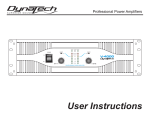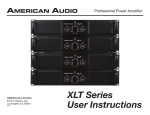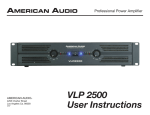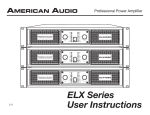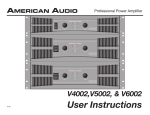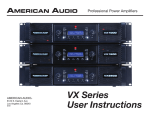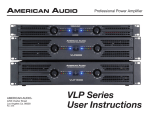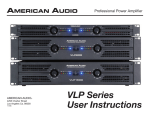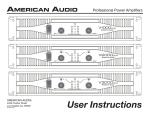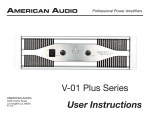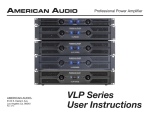Download Unika A-800 User manual
Transcript
UNiK A Professional Power Amplifiers POWER POWER ON PROTECT A-500 UNiK A CLIP -10dB -20dB OFF SIGNAL 0 10 LIMITER POWER PROFESSIONAL POWER AMPLIFIER 0 LIMITER POWER ON ON 10 ON PROTECT A-800 UNiK A CLIP -10dB -20dB OFF SIGNAL 0 10 LIMITER POWER PROFESSIONAL POWER AMPLIFIER 0 LIMITER POWER ON ON 10 ON PROTECT A-1300 UNiK A CLIP -10dB -20dB OFF 0 SIGNAL 10 PROFESSIONAL POWER AMPLIFIER 0 10 User Instructions This symbol is intended to alert the user to the presence of non insulated "dangerous voltage" within the product's enclosure that may be of sufficient magnitude to constitute a risk of electric shock to persons. This symbol is intended to alert the user of the presence of important operating and maintenance (servicing) instructions in the literature accompanying the product. CAUTION: Risk of the electrical shock - DO NOT OPEN! CAUTION: To reduce the risk of electrical shock, do not remove cover. No user serviceable parts inside. Refer all servicing to qualified service personnel. WARNING: To prevent electrical shock or fre hazard, do not expose this amplifier to rain or moisture. Before using this amplifier read the user manual for further warnings. Este símbolo tiene el propósito de alertar al usuario de la presencia de “voltaje peligroso“ que no tiene aislamiento dentro de la caja del producto que puede tener una magnitud sufciente como para constituir riesgo de corrientazo. Este símbolo tiene el propósito de alertar al usuario de la presencia de instrucciones importantes sobre la operación y mantenimiento en la literatura que vienc con el producto. PRECAUCIÓN: Riesgo del choque eléctrico - NO SE ABRA PRECAUCIÓN: Para disminuir el riesgo de choque eléctrico, no quite la cubierta. No hay piezas adentro que el usario puede reparar. Deje todo mantenimiento al los técnicos cualifcados. ADVERTENCIA: Para prevenir choque eléctrico o riesgo de incendios, no deja expuesto a la lluvia o a la humedad este amplifcador. Antes de usar este amplifcador, lea mas advertencias en la guia de operacion. Ce symbole est utilisé pur indiquer à l’utilisateur la présence à l'intérieur de ce produit de tension non-isolée dangereuse pouvant être d'intensité suffsante pour constituer un risque de choc électrique. Ce symbole est utilisé pour indiquer à l’utilisateur qu'il trouvera d'importantes instructions importantes sur l'utilisation et l'entretien de l'appareil dans la littérature accompagnant le produit. ATTENTION: Risque de choc électrique - NE PAS OUVRIR! ATTENTION: Afin de réduire le risque de choc électrique, ne pas enlever le couvercle. Il ne se trouve à l’intérieur aucune piéce pouvant être réparée par l'utilisateur. Confier l'entretien à un personnel qualifé. AVERTISSEMENT: Afin de prévenir les risque de décharge ou de feu, n’exposez pas cet appareil à la pluie ou à l’humidité. Avant d’utiliser cet amplificateur, lisez les avertissements supplémentaries situés dans le guide. Dieses Symobl soll den Anwender vor unisollierten gefährlichen Spannungen innerhalb des Gehäuses warnen, die von Ausreichender Stärke sind, um einen elektrischen Schlag verursachen zu können. Dieses Symobl soll den Benutzer auf wichtige Instruktionen in der Bedienungsanleitung aufmerksam machen, die Handhabung und Wartung des Produkts betreffen. VORSICHT: Risiko - Elektrischer Schlag! Nicht öffnen! VORSICHT: Um ddas Risiko eines elektrischen Schlages zu vermeiden, nicht die Abdeckung enfernen. Es befnden sich keine Teile darin, die vom Anwender repariert werden könnten. Reparaturen nur von qualifzierte Fachpersonal durchführen lassen. ACHTUNG: Um einen elektrischen Schlag oder Feuergefahr zu vermeiden, sollte diesen Gerät nicht dem Regen oder Feuchtigkeit ausgesetz werden. Vor Inbetriebnahme unbedingt die Bedienungsanleitung lesen. page 2 CAUTION Do not open risk of electric shock CAUTION: TO REDUCE THE RISK OF ELECTRIC SHOCK, DO NOT REMOVE THE COVER. THERE ARE NO USER SERVICEABLE PARTS INSIDE. REFER ALL SERVICE TO YOUR AUTHORIZED AMERICAN AMX DEALER. The lightning flash with an arrow triangular symbol is intended to alert the user to the presence of non insulated “dangerous voltage” within the products enclosure, and may be of sufficient magnitude to constitute a risk of electric shock. The exclamation point triangular symbol is intended to alert the user to the presence of important operating and maintenance (servicing) instructions in the user manual accompanying the amplifier. FOR OPTIMUM PERFORMANCE AND RELIABILITY DO NOT PRESENT THE AMPLIFIER WITH A SPEAKER LOAD OF LESS THAN 2 OHMS OR ANY COMBINATION OF SPEAKERS THAT TOGETHER ARE LESS THAN 2 OHMS! USING ONE SPEAKER, IT MUST BE R AT E D AT 4 O R M O R E O H M S . USING TWO SPEAKERS, THEY MUST RATED EACH AT 4 OR MORE OHMS. USING THREE SPEAKERS, THEY MUST BE RATED EACH AT 8 OR MORE OHMS. POUR ASSURER LA FIABILETE ET OBTENIT UNE PERFORMANCE OPTIMALE, NESOUMETTE JAMAIS L’AMPLIFICATEUR A UNE CHARGE D’IMPEDANCE TOTALE INFERIEURE A 2 OHMS, NI AVEC UN H.P. N EN COMBINAISON DES H.P. AVEC UN H.P., IL FAUT UNE CHARGE D’IMPEDANCE MINIMUM DE 2 OHMS. AVEC DEUX H.P., FAUT POUR CHAOUN UNE CHARGE D’IMPEDANCE MINIMUM DE 4 OHMS. AVEC TROIS H.P., FAUT POUR CHAOUN UNE CHURGE D’IMPEDANCE MINIMUM DE 8 OHMS. CONTENTS: Introduction.................................................................................................................................................................4 Front Panel...................................................................................................................................................... ............5 Rear Panels A-500......................................................................................................................................................................6 A-800......................................................................................................................................................................7 A-1300....................................................................................................................................................................8 Inputs.........................................................................................................................................................................9 Outputs.......................................................................................................................................................................9 Operating Modes........................................................................................................................................................13 Protection Circuitry Limiter...................................................................................................................................................................13 Short Circuit Protection...........................................................................................................................................13 Thermal Protection.................................................................................................................................................14 Low Cut Filter.........................................................................................................................................................14 Specifications............................................................................................................................................................15 page 3 Important Precautions Introduction • To reduce the risk of electrical shock or fire, do not expose this unit rain or moisture • Do not spill water or other liquids into or on to your unit • Do not attempt to operate this unit if the power cord has been frayed or broken • Do not attempt to remove or break off the ground prong from the electrical cord. This prong is used to reduce the risk of electrical shock and fre in case of an internal short • Disconnect main power before making any type of connection • Do not remove the cover under any conditions. There are no user serviceable parts inside • Never plug this unit in to a dimmer pack • Always be sure to mount this unit in an area ar ea that that will will allow allow proper pr oper ventilation. Allow about 6” (15cm) between this device and a wall • Do not attempt to operate this unit, if it becomes damaged • This unit is intended for indoor use only, use of this product outdoors voids all warranties • During long periods of non-use, disconnect the unit’s main power • Always mount this unit in a safe and stable manner • Power cords should be routed so they are not likely to be walked on, pinched by items placed upon or against them. • Cleaning -The outside of the unit should be wipe down with a soft cloth and mild cleaner when needed. • Heat -The amplifier should be situated away from heat sources such as radiators, heat registers, stoves, or other appliances (including amplifiers) that produce heat. • The fixture should be serviced by by qualified qualified service service personnel personnel when: when: A. The power-supply cor cordd or or the the plug plug has has been been damaged. damaged. B. Objects have fallen, or liquid has been spilled into the unit. C. The appliance has been exposed to rain or water. D. The fixture does not appear to operate normally or exhibits a marked change in performance. Introduction: Congratulations and thank you for purchasing an UNiKA’s A series amplifier. This amplifier is a representation of UNiKA’s continuing commitment to produce the best and highest quality audio products at an affordable price. These amplifiers are designed to provide a big impact in sound reproduction. Please read and understand this manual completely before attempting to operate your new amplifier. This booklet contains important information concerning the proper and safe operation of your new amplifier. Unacking: Every A series amplifier has been thoroughly tested and has been shipped in perfect operating condition. Carefully check the shipping carton for damage that may have occurred during shipping. If the carton appears to be damaged, carefully inspect your unit for any damage and be sure all accessories necessary to operate the system have arrived intact. In the event damage has been found or parts are missing, please contact your dealer for further instructions. Installation: This amplifier is designed to mount into a standard 19” rack. The front panel provides four holes used to screw the unit into a rack. The unit also provides a way to rear mount the unit into a rack for added security. Rear mounting the unit is especially recommended if the unit is to mounted into a mobile rack. page 4 CONTROLS AND FUNCTIONS FRONT PANEL 1 2 4 5 6 3 LIMITER POWER 7 8 LIMITER POWER ON ON ON PROTECT A-800 UNiK A CLIP -10dB -20dB OFF 0 9 SIGNAL 10 PROFESSIONAL POWER AMPLIFIER 10 11 0 12 13 1. Power Switch - This switch controls the units main power. 2. Channel 1 Limiter Switch (A-800 & A-1300 Only) -This is used 10 9 Diagram 1 7. Channel 2 Clip Indicator - This red LED will begin to flash when to activate the channels built-in limiter. The limiter reduces the average output level when the signal begins to distort, this process is designed to reduce distortion and protect the speakers. See limiter page 13. channel two begins to overload (clip). At this point channel one will begin to distort. Under heavy clipping activity lower the channel one gain control to reduce the risk of damage to your speakers and amplifier. This LED may glow when the unit has been turned off, this is normal. 3. Channel 1 Clip Indicator - This red LED will begin to flash when 8. Channel 2 Limiter Switch ( A-800 & A-1300 Only) -This is used channel one begins to overload (clip). At this point channel one will begin to distort. Under heavy clipping activity lower the channel one gain control to reduce the risk of damage to your speakers and amplifier. This LED may glow when the unit has been turned off, this is normal. to activate the channels built-in limiter. The limiter reduces the average output level when the signal begins to distort, this process is designed to reduce distortion and protect the speakers. See limiter page 13. 9. Cooling Vents - These vents are used for proper cooling. Never 4. Channel 1 Protect Indicator - The red Protect LED will begin to block these vents and keep them clean at all times. glow when the channel goes into protect mode. When the channel goes into protect mode all output for that channel will turn off. This is to protect any speakers connected to the channel. 10. Channel 1 Gain Control - This rotary knob is used to control the 5. Power Indicator - This blue LED will glow when main power is ap- 11. Channel 1 Signal Indicators - These green and yellow LED’s will plied to the unit. This light may continue to glow briefy after main power has been turned off, this is normal. glow according to the average signal output. 6. Channel 2 Protect Indicator - The red Protect LED will begin to glow according to the average signal output. glow when the channel goes into protect mode. When the channel goes into protect mode all output for that channel will turn off. This is to protect any speakers connected to the channel. 13. Channel 2 Gain Control - This rotary knob is used to control the output signal of channel one. Turning the knob in a clockwise direction will increase signal output. 12. Channel 2 Signal Indicators - These green and yellow LED’s will output signal of channel two. Turning the knob in a clockwise direction will increase signal output. page 5 A-500 REAR PANEL 1 2 3 PROFESSIONAL POWER AMPLIFIER 4 5 CAUTION WARNING: TO REDUCE THE RISK OF FIRE OR ELECTRICAL SHOCK DO NOT EXPOSE THIS EQUIPMENT TO RAIN OF MOISTURE AVIS: VIS: RISQUE DE CHOC ELECTELECT TRIQUE - NE PAS OUVRIR. 4 OHMS MINIMUM IMPEDANCE PRE CHANNEL 4 OHMS MINIMUM IMPEDANCE IN MONO BRIDGE MODE _ INPUT CH 2 6 INPUT CH 1 BRIDGE MONO + CH 1 CH 2 + P2 P3 P1 _ - + + + + - _ STEREO BRIDGE OUTPUT OUTPUT Diagram 2 7 8 Connect your channel two speakers to channel two output. 1. Channel 2 Input - Connect the input source for channel two to either the balance XLR or the balanced/unbalanced 1/4” input jacks. The 1/4” TRS plug is configured as follows; Tip is positive, Ring is negative and Sleeve is ground. The XLR jack is configured as follows; Pin three positive, pin two negative, pin one ground. See page 9 for more details on input configuration. 2. Channel 1 Input - Connect the input source for channel one to either the balance XLR or the balanced/unbalanced 1/4” input jacks. The 1/4” TRS plug is configured as follows; Tip is positive, Ring is negative and Sleeve is ground. The XLR jack is configured as follows; Pin three negative, pin two postive, pin one ground. See page 9 for more details on input configuration. 5. Channel 1 Speaker Output - 5 Way Binding Post - Connect your channel one speakers to channel one output. 6. Circuit Breaker - This breaker is designed to protect the amplifier and your speakers in the event of an AC overload. In the event of an electrical overload the breaker will pop-out. To reset the breaker, push it in. If the breaker continues to pop, stop using the amplifier and contact your dealer. 7. Mono-Bridge/Stereo Selectable Switch - This switch changes the amplifier operating mode from either stereo or mono bridge. Amplifiers arrive to you preset in the stereo operation mode. 3. Cooling Fan - 8. A/C Power Input - This is a dual speed cooling fan. This fan is used to cool the internal parts of the amplifier when in use. Never block the fan in any way or mount in an enclose rack, doing so may cause the amplifier to overheat and fail. Plug this cable in to a standard 110- 220V wall outlet. Be sure that supplied voltage matches that of the required voltage of you amplifier. Never plug your amplifier in to a wall outlet that you not match the required voltage of your amplifier, serious damage may occur to your unit. 4. Channel 2 Speaker Output - 5 Way Binding Post - page 6 A-800 REAR PANEL 1 3 2 4 1 3 2 4 5 6 1 Diagram 3 7 8 9 10 1. Cooling Fan Dual speed cooling fans. These fans are used to cool the internal parts of the amplifier. Never block the fan grills in any way or mount in an enclose rack, doing so may cause the amplifier to overheat and fail. 2. Channel 2 Input Connect the input source for channel two to either the balance XLR or the balanced/unbalanced 1/4” input jacks. The 1/4” TRS plug is configured as follows; Tip is positive, Ring is negative and Sleeve is ground. The XLR jack is configured as follows; Pin three negative, pin two positive, pin one ground. See page 9 for more details on input configuration. 3. Low Cut Filter Mode Switches These dip switches are used to active and adjust the built-in Low Cut Filter, see "Low Cut Filter" on page 14. 4. Channel 1 Input Connect the input source for channel one to either the balance XLR or the balanced/unbalanced 1/4” input jacks. The 1/4” TRS plug is configured as follows; Tip is positive, Ring is negative and Sleeve is ground. The XLR jack is configured as follows; Pin three negative, pin two positive, pin one ground. See page 9 for more details on input configuration. 5. Mono-Bridge/Stereo Selectable Switch This switch changes the amplifier operating mode from either stereo or mono bridge. Amplifiers are shipped in stereo mode. 6. Fuse Holder - 11 12 This holder houses the external fuse. Always replace with the exact same type fuse. 7. Channel 2 XLR THRU Jack This jack is used to send a parallel signal from the channel two input jacks to another device or amplifier. 8. Channel 1 XLR THRU Jack This jack is used to send a parallel signal from the channel one input jacks to another device or amplifier. 9. Channel 2 Output Jack/5 way Binding Post Connect to your speaker’s input jack. Red is positive signal and Black is negative signal. 10. Channel 1 Output Jack/5 way Binding Post Connect to your speaker’s input jack. Red is positive signal and Black is negative signal. 11. Ground Lift Switch This switch is used to disconnect the internal ground signal from the amplifier chassis ground. This may reduce the buzz that is caused from an electrical 50Hz cycle. 12. A/C Power Input Plug this cable in to a standard 110-220V wall outlet. Never plug your amplifier in to a wall outlet that does not match the required voltage of your amplifier, serious damage may occur to your unit. page 7 A-1300REAR PANEL 1 2 3 5 4 6 1 3 2 4 7 8 9 1 Diagram 4 10 11 12 13 1. Cooling Fan - Dual speed cooling fans. This fans are used to cool the internal parts of the amplifier when in use. Never block the fan grills in any way or mount in an enclose rack, doing so may cause the amplifier to overheat and fail. 2. Channel 2 Subwoofer Mode On/Off Switch - This switch activates the amplifier subwoofer mode for channel two. 3. Channel 2 Frequency Adjustment. - This pot is used to adjust the frequency response when running channel two in subwoofer mode. 4. Channel 2 Input - Connect the input source for channel two to either the balance XLR or the balanced/unbalanced 1/4” input jacks. See page 9 for more details on input configuration. 5. Low Cut Filter Mode Switches - These dip switches are used to activate and adjust the built-in Low Cut Filter, see "Low Cut Filter" on page 14. 6. Channel 1 Input - Connect the input source for channel one to either the balance XLR or the balanced/unbalanced 1/4” input jacks. See page 9 for more details on input configuration. 7. Channel 1 Frequency Adjustment.- This pot is used to adjust the frequency response when running channel two in subwoofer mode. 8. Mono-Bridge/Stereo Selectable Switch - This switch changes the amplifier operating mode from either stereo or mono bridge. Amplifiers are shipped in stereo mode. 14 15 16 9. Fuse Holder - This holder houses the external fuse. Always replace with the exact same type fuse. 10. Channel 2 XLR THRU Jack - This jack is used to send a parallel signal from the channel two input jacks to another device or amplifier. 11. Channel 1 XLR THRU Jack - This jack is used to send a parallel signal from the channel one input jacks to another device or amplifier. 12. Channel 2 Output Jack/5 way Binding Post - Connect to your speaker’s input jack. Red is positive signal and Black is negative signal. 13. Channel 1 Output Jack/5 way Binding Post - Connect to your speaker’s input jack. Red is positive signal and Black is negative signal. 14. Ground Lift Switch - This switch is used to disconnect the internal ground signal from the amplifier chassis ground. This may reduce the buzz that is caused from an electrical 50Hz cycle. 15. Channel 1 Subwoofer Mode On/Off Switch - This switch activates the amplifier subwoofer mode for channel one. 16. A/C Power Input - Plug this cable in to a standard 110-220V wall outlet. Be sure that supplied voltage matches that of the required voltage of you amplifier. Never plug your amplifier in to a wall outlet that does not match the required voltage of your amplifier, serious damage may occur to your unit. page 8 Set Up INPUTS - The A series amplifiers allows you to use two types of input connectors per a channel, a XLR jack for balanced connections and a 1/4” female jack that will accept balanced and unbalanced connectors. Use these connections to connect the output signal from a mixer, cross-over or EQ to your A series amplifier. A balanced connection is recommended for cable runs longer that 20ft. When constructing your own XLR cables follow the pin configuration describe below for proper connections. For cable runs shorter than 20ft. you may choose the 1/4” unbalanced input option. The 1/4” unbalanced input option may be more convenient for most users due to the abundant supply of prefabricated cables available at your local audio dealer. You may use the two XLR “Input Thru” jacks to jump a parallel connection to another amplifier or other device. For Example: Connect a XLR cable to the input of channel one. You may now connect a XLR cable from the channel one “Input Thru” jack to the input jack of another amplifier’s channel one input. This will reduce the use of “Y” cables. Male XLR Pin Configuration: Balanced TRS 1/4” Plug Unbalanced TS 1/4” Plug US ITT Standard 3 1 Diagram 5 2 3 Negative (-data) 1 Ground / Return / 0v Diagram 6 Hot (+) Ground/Shield Negative (-) Diagram 7 Hot (+) Negative (-) 2 Hot (+data) OUTPUTS: Binding Post/Banana Plug - Connect your speakers to the binding post outputs on the rear of the amplifier. The speaker wire may be connect by bare wire (directly connected, usually for permanent connections), banana plug, or spade connector. Connections are made to Channels 1 and 2 output’s for stereo mode or across the red terminals of Channels 1 and 2 for Mono Bridge Mode. Important Notice: Although a speaker will operate with the positive and negative leads plugged into either terminal on the amplifier binding post, be sure to plug the negative lead into the black terminal and positive lead into Diagram 8 the red terminal. Ensuring proper polarity will avoid speakers being out of phase, that can cause a loss of bass response. Important Notice: Banana Plugs - When connecting your speakers to the amplifier using banana jacks; Be sure that the red and black caps on the binding post are completely screwed in. Insert the banana jacks into the caps of the binding post, be sure that the banana jack is inserted securely to avoid the risk of it popping out. page 9 Diagram 10 Bare Wire Connections: When connecting your speakers to the amplifier using bare wire; Unscrew the red and black caps on the binding post, be sure not to completely remove or unscrew the red and black caps. Strip back the wire insulation 1/2” (13mm). Insert the bare wire into the hole that was reveled by unscrewing the binding post cap. After inserting the wire into the binding post hole, screw the binding post cap down on the wire. To reduce the risk of shock or damage to your amplifier, be sure that the wire connected to one binding post does not come in contact with that of another. Typical speaker output using bare wire. Insert bare wire into the binding post and tighten. Diagram 11 Spade Connector: (Diagram 6) When connecting your speakers to the amplifier using spade connector; Unscrew the red and black caps on the binding post, be sure not to completely remove or unscrew the red and black caps. Insert the spade connector in to the binding post and tighten the caps down on the spade connector. To reduce the risk of shock or damage to your amplifier, be sure that the wire connected to one binding post does not come in contact with that of another. When connecting your speakers to the amplifier using banana jacks; Be sure that the red and black caps on the binding post are tighten down completely. Insert the banana jacks into the caps of the binding post, be sure that the banana jack is inserted securely to avoid the risk of it popping out. Mono Bridge Connections: Mono bridge operation connections will follow the above descriptions however, when operating in mono bridge operation the speaker connections will run between the two positive (red) leads. Use channel two positive output terminal for the negative connection and the channel one positive output terminal for the positive connection. PROFESSIONAL POWER AMPLIFIER INPUT CH 2 Diagram 12 XX Typical speaker output using spade connectors. Insert bare wire into the binding post and tighten. CAUTION WARNING: TO REDUCE THE RISK OF FIRE OR ELECTRICAL SHOCK DO NOT EXPOSE THIS EQUIPMENT TO RAIN OF MOISTURE AVIS: RISQUE DE CHOC ELECTELECT TRIQUE - NE PAS OUVRIR. 4 OHMS MINIMUM IMPEDANCE PRE CHANNEL 4 OHMS MINIMUM IMPEDANCE IN MONO BRIDGE MODE CH 2 INPUT CH 1 BRIDGE MONO 6 A M P + CH 1 120V~60Hz 1000 WATTS WA ATTS + P2 P3 P1 - + + - STEREO BRIDGE OUTPUT Uses Channel 1 Inputs Only 4 Ohm Minimum Speaker Load page 10 Rear A-500 Typical Stereo Output Connections A-500 shown in illustration PROFESSIONAL POWER AMPLIFIER INPUT CH 2 CAUTION WARNING: TO REDUCE THE RISK OF FIRE OR ELECTRICAL SHOCK DO NOT EXPOSE THIS EQUIPMENT TO RAIN OF MOISTURE AVIS: RISQUE DE CHOC ELECTELECT TRIQUE - NE PAS OUVRIR. 4 OHMS MINIMUM IMPEDANCE PRE CHANNEL 4 OHMS MINIMUM IMPEDANCE IN MONO BRIDGE MODE CH 2 INPUT CH 1 BRIDGE MONO + CH 1 6 A M P 120V~60Hz 1000 WATTS WA ATTS + P2 P3 P1 - + + - STEREO BRIDGE OUTPUT SPEAKERS 4 OHM MINIMUM Diagram 13 SPEAKERS 4 OHM MINIMUM A-500 shown in illustration PROFESSIONAL POWER AMPLIFIER INPUT CH 2 WARNING: TO REDUCE THE RISK OF FIRE OR ELECTRICAL SHOCK DO NOT EXPOSE THIS EQUIPMENT TO RAIN OF MOISTURE AVIS: RISQUE DE CHOC ELECTELECT TRIQUE - NE PAS OUVRIR. CAUTION 4 OHMS MINIMUM IMPEDANCE PRE CHANNEL 4 OHMS MINIMUM IMPEDANCE IN MONO BRIDGE MODE CH 2 INPUT CH 1 BRIDGE MONO 6 A M P + CH 1 120V~60Hz 1000 WATTS WA ATTS + P2 P3 P1 - + + - STEREO BRIDGE OUTPUT Diagram 14 Use Channel 1 Inputs Only TYPICAL MONO BRIDGE SET-UP SPEAKERS 8 OHM MINIMUM page 11 Typical Stereo Set-Up Diagram 15 Typical Mixer A1300 series (Rear View) 1 3 2 4 Typical Speaker Connect to Vplus series Channel Two Output Typical Speaker Connect to Vplus series Channel One Output page 12 OPERATING MODES: Stereo Operation - Page 12/Diagram 15 details an example of a typical stereo set-up. Connect your inputs into channels one and two of the amplifier. Connect your speakers to the outputs on the rear of the amplifier. Be sure that your front gain controls are turned down to their lowest level (full counter-clockwise). Turn your amp on. Turn your input source level up. Use your front gain controls to regulate the output volume. Be sure not to raise the volume to the clip level, however an intermittent clip signal is acceptable. Mono Bridge Operation - Page 11/Diagram 14 details a mono bridge set-up. Be sure your amplifier and all other audio equipment is powered down. Flip the Stereo/Mono Bridge switch to the Mono Bridge position. Connect an input signal to channel one. Connect your speaker across the red output binding post on the rear of your amplifier. Turn your equipment on (your amplifier should always be the last item you turn on). Apply an input source signal to your amplifier. Turn channel two gain up. Use the channel one gain to regulate your amplifier output. Bridged-Mono Mode Caution - The voltage across the output terminals of a bridged A series amplifier may equal or exceed 100 volts RMS and may be as high as 130 volts. Use fully insulated CLASS ONE wiring, and the load must be rated for up to 2500 watts (@4 ohms) PROTECTION: LIMITER - The A series comes with a built in limiter. When the input signal overloads, the “CLIP LED’s” indicate a signal overload, at this time, the master volume should be lowered to reduce distortion. If the input gain level is not reduced the built-in limiter will activate. During signal overload, the limiter will reduce the input audio signal enough to minimize the amount of clipping. A limiter takes the gain of an overloading signal and reduces it, the reduction in gain reduces distortion that can cause damage to your speakers and amplifier. During normal operation below clipping, and momentary clips on peaks, the limiter does not affect the audio signal and is inaudible. It will allow brief clipping of peaks and will only activate when continuous, hard clipping occurs. During excessive clipping the limiter will reduce the audio signal enough to minimize the amount of clipping. When the input signal decreases enough that clipping ends, the limiter will deactivate and cease its gain reduction. The limiter has a fixed threshold and can not be adjusted. Safe Power Levels at Different Output Loads: 8-Ohm Loads: The amplifier can operate at practically any power level without risk of overheating. However, if it is pushed hard enough to continually light the “CLIP ” indicator, the amplifier’s average output power can reach 150 watts. 4-Ohm Loads: If the “CLIP ” indicator flashes occasionally, the amplifier is approaching its maximum long-term power capacity. If it is lit about half the time, the amplifier channel will probably go into thermal protection within a few minutes. 2-Ohm Loads: Except for an occasional flash, keep the “CLIP ” indicator dark to avoid overheating the amplifier channel. Clipping should be kept to a reasonable minimum. An amplifier’s peak current draw at full output power into 2 ohms is several times what the “normal ” draw is, but its various protection circuits will prevent this condition lasting more than a minute or two. Short Circuit Protection - The A series amplifiers all come with built-in Output Short Circuit Protects. The Output Short Circuit Protection protects the output devices of the amplifier from short circuits and stressful loads. If your speaker lines short, the amplifier automatically detects this problem and discontinues operation for that channel. If one side of your amplifier becomes shorted and page 13 goes into protect mode, the other side will continue to operate normally. During short circuit protection, the "Clip" LED and “Protect" LED will light simultaneously indicating amplifier fault. All channel output during the “Short Circuit Protection" will be interrupted (i.e. no sound output). Short Circuit Protection can usually be traced back to the signal output line (i.e. speaker line). Check the line from the output terminal of the amplifier to the speaker. If this line good, check the internal speaker connections and components. A short circuit will usually be traced to a bad cable or a bad speaker component and is rarely traced to the amplifier itself. Thermal Protection - A single variable-speed fan on the A-500 and dual variable speed fans on the A-800 and A-1300 amplifiers provide adequate cooling. During low level output the fans run at normal speeds. During high output and as heat raises, (exceeding 90°C.), the fans will run at higher speeds to aid the cooling process. If the heatsink temperature exceeds 91°C., the amplifier will mute until the amplifier cools down. When the amplifier cools below 90°C., the amplifier will return to normal operations. Be sure not to operate your amplifier below the minimum load ratings to reduce the risk of overheating problems. Input/Output Protection - The input circuits are isolated by 10k resistors. An ultrasonic network uncouples RF from the output and helps keep the amplifier stable with reactive loads. Operating Voltage (AC Mains) - The serial number label indicates the correct AC main voltage. Connecting to the wrong voltage is dangerous and may damage the amplifier. Always be sure the source voltage for your areas matches the required voltage for your amplifier. Gain Controls - The gain controls are located on the front panel and are calibrated in 2dB of attenuation from full gain. It is best to adjust the amplifier so no “hissing” is heard from speakers with no music being played, this will ensure the lowest possible distortion during normal operation. Low Cut Filter (A-800 and A-1300 Only) -The low-cut filter removes extremely low frequencies from the audio signal that could cause speaker distortion or damage. The dip switches on the rear panel allows you to enable or disable the filter for each channel, as well as adjust either a 50Hz or 30 Hz cut-off. Always use the 50 Hz filter setting if you are using the amplifier to drive a distributed line system (also known as a constant-voltage line, 70 volt line, etc.). The dip switches on the rear panel allows you to configure the low cut filter. The diagram below detail the functions of each dip switch, the functions are also printed on the rear panel of the amplifier. Configuring the Low Cut Filter: Activating Low Cut Filters - Dip switches 1 and 4 activate and deactivate the Low Cut Filter. Channel 1 filters is control by dip switch 1 and channel 2 filter is controlled by dip switch 4. Low Cut Frequency Selector - When the Low Cut Filter is activated, dip switches 2 (channel 1) and 3 (channel 2) will control the frequency roll-off. When dip switches 2 and 3 are in the "ON" the filter will cut off frequencies at and below 30Hz, when these dip switches are in the "OFF" position the filter will cut off frequencies at and below 50Hz. Please note: Each channel operates independently of each other allowing each channel to have different filter settings. page 14 OFF ON 1 2 3 4 CH. 1 CH.2 1 Low Cut 3 ON=30Hz On/Off 2 ON=30Hz OFF=50Hz OFF=50Hz 4 Low Cut On/Off A-SERIES AMPLIFIER SPECIFICATIONS MODEL NO: A-500 Output Power: 2 ohms, 1 Khz 1% THD 4 ohms, 1 Khz 1% THD 8 ohms, 1 Khz 1% THD (Bridge Mode, mono) 4 ohms, 1 Khz 1% THD 8 ohms, 1 Khz 1% THD A-800 A-1300 A-2000 A-3000 A-4000 300w RMS Stereo. 250w RMS Stereo. 170w RMS Stereo. 620w RMS Stereo. 450w RMS Stereo. 260w RMS Stereo. 1000w RMS Stereo. 700w RMS Stereo. 420w RMS Stereo. 1200w RMS Stereo. 1000w RMS Stereo. 620w RMS Stereo. 1600w RMS Stereo. 1400w RMS Stereo. 840w RMS Stereo. 2400w RMS Stereo. 2000w RMS Stereo. 1200w RMS Stereo. 600w RMS 510w RMS 1240w RMS 900w RMS 2000w RMS 1400w RMS 2400w RMS 2000w RMS 3200w RMS 2800w RMS 4800w RMS 4000w RMS 1.1v RMS (0 dBv) 1v RMS (0 dBv) 5.25" (13.3cm) 19" (48.3cm) 15.9" (40.7cm) 55 lbs. (25kg) 5.25" (13.3cm) 19" (48.3cm) 18.2" (46.2cm) 72.8 lbs. (33kg) 18A @ 120v AC 21A @ 120v AC Total Harmonic Distortion 20Hz-20kHz, @ rated output power, 8 ohms Input Sensitivity and Impedance: @ rated output power, 8 ohms Dimensions & Weight: Height Width Depth Weight Less than 0.02% 1.5v rms 3.5" (8.8cm) 19" (48.3cm) 15.9" (40.7cm) 26.4 lbs. (12kg) 1.0v RMS (0 dBv) 3.5" (8.8cm) 19" (48.3cm) 15.9" (40.7cm) 30 lbs. (13.6kg) 3.5" (8.8cm) 19" (48.3cm) 15.9" (40.7cm) 31 lbs. (14kg) Frequency Response: +/- 1db, 1w RMS. 8 ohms +/- 0.2 db, @ rated output, 8 ohms 10 Hz - 40 kHz 20 Hz - 20 kHz Hum & Noise: Below rated output,8 ohms Power Consumption: @ rated output power, 8 ohms Cooling System: 5.25" (13.3cm) 19" (48.3cm) 15.9" (40.7cm) 61.7 lbs. (28kg) 100 dB, unweighted 5A @ 120v AC 7A @ 120v AC 10A @ 120v AC 20A @ 120v AC 2 Dual Speed Fans and Heatsinks 1 Dual Speed Fan and Heatsinks page 15















